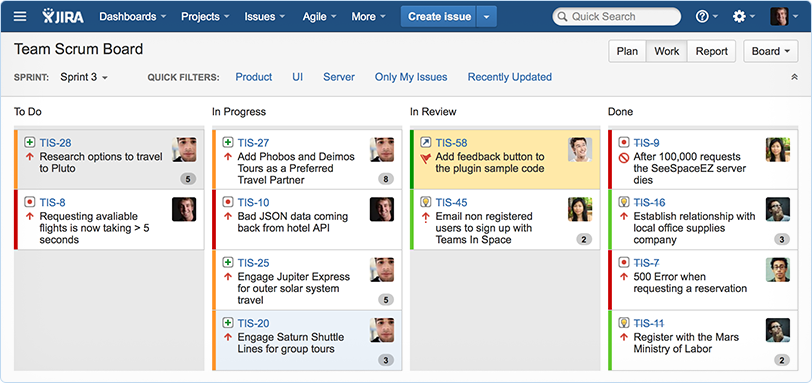Scrum. The Right Way to Do Mobile Product Development for Startups.
If you’re a (mobile) startup, you probably know how hard it is to keep everything (and everyone) organized. Developers, testers, marketers, designers, product managers, investors and every other stakeholder have to be constantly communicating, so that all project specifications are understood and simultaneously internalized.
Without the proper structuring of operations, things can go crazy in very little time. You must have at least once been part of an unsatisfactory situation in which the client’s directions were understood and applied differently within the team. If the project manager uses inappropriate coordination methods, the team loses sight of the whole picture and, before you know it, the client is no longer on board. Many startups fail because of “the lack of a tailored management process”, Eric Ries believes.
This is why SCRUM is essential to project planning. No project can be undergone successfully without proper overview, coordination and structuring. And SCRUM is perfect at doing just that. Here’s how.
The ABCs of agile mobile product development
As defined by the Scrum Alliance, Scrum represents
A simple yet incredibly powerful set of principles and practices that help teams deliver products in short cycles, enabling fast feedback, continual improvement, and rapid adaptation to change.
Another definition, by Wikipedia this time, states that Scrum is “an iterative and incremental agile software development framework for managing product development”.
Others believe that you can do waterfall and agile at the same time.
Although initially designed to suit the needs of the software industry (as the leading Agile development framework), SCRUM is now used by publishing agencies, by consulting groups and many others.
As a mobile app company, working with startups on developing new products and platforms, we have become accustomed to working under the Scrum parameters and - truth be told - we see no other viable alternative for conducting efficient project management. Here’s how.
Change is done gradually and at every level.
In the last 3 years we’ve spent working with startups, we have had to adapt our team structure and processes to best serve them. It wasn’t easy, but had we not done it, we probably wouldn’t have lasted one year in the mobile industry.
Unlike an enterprise software project, working on a startup product development project requires continuous, grassroots change. This affects all layers of the process:
- the high-level roadmap, which evolves as talks with potential clients, users or investors advance
- the content of functionality modules, which changes based on new ideas or technologies that come on the market, either as competitors or as enablers
- the design and UX, screen flows, which evolve as the product is developed; more people are involved in the process and new ideas surface, including for certain screens and actions that had been deemed accomplished
- the vocabulary and communication used in all the marketing materials, which also have an impact on the vocabulary of the product
This greatly impacts the team working on the product, as this must own both
- the skills and processes to manage the project efficiently and to avoid unnecessary rework
- AND the attitude and open mind required for adapting in a constantly evolving and changing context
Advantages of working the SCRUM way
You can build the product that the users/customers really need.
By adapting along the way, you avoid the type of scenario in which you would take 3 months, full-time, to document a product that will require 1 year to develop, only to see at the end that the result is not what users/customers are willing to pay for.
You can start small, with an MVP
This means you can work on the first version of the product, even if you don’t know what the final end result will look like.
From our experience, you mustn't focus on the end result too much, because it will change along the way. The more you work on the clickable prototype and test it with potential users, the more changes will occur. And it is all for the better.
Predictability and accountability are key
Although it isn’t possible to entirely foresee the deployment of a product (we will detail further, during the disadvantage section), having complete control over who does what means smaller risk.
There is one drawback to SCRUM: visibility is jeopardised
You can never be in possession of all the details from the very beginning. And since a lot of things change along the way, it’s nearly impossible to claim, with 100% certainty, how much time and effort will be required in 6 months' time to work on module X; or, for that matter, exactly on what you will be working in 6 months’ time.
Further resources
There are multiple tools that integrate the SCRUM principles and that can ease your workflow. Some of them come free of charge (Freedcamp), others require a monthly/yearly subscription (Jira, Basecamp, Mingle). Some of them are free up to 5 users. None of them are too expensive compared to the tremendous transformation it will instill within your company process.
The internet is packed with tutorials, books, courses and consultancy companies that offer great training in Agile development. Here are several additional links that could help along the way:
- http://scrumfoundation.com/on-site-training
- https://www.scrum.org/Resources
- http://www.scrumguides.org/ (the official website where you can download Ken Shwaber and Jeff Sutherland’s guide on working with SCRUM).
In conclusion, try integrating “the Scrum way” as quickly as possible in the working of your startup. Don’t get hindered by costs, lack of time, or human resources. After all, many organizations have started from scratch and are now professional users of SCRUM. It is mandatory that you understand its importance for structuring your processes and, hence, creating a healthy, structured work environment. It’s the shortest way to develop any type of product in a neat, potentially risk-free manner.
